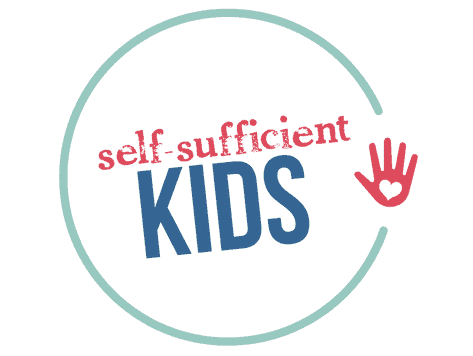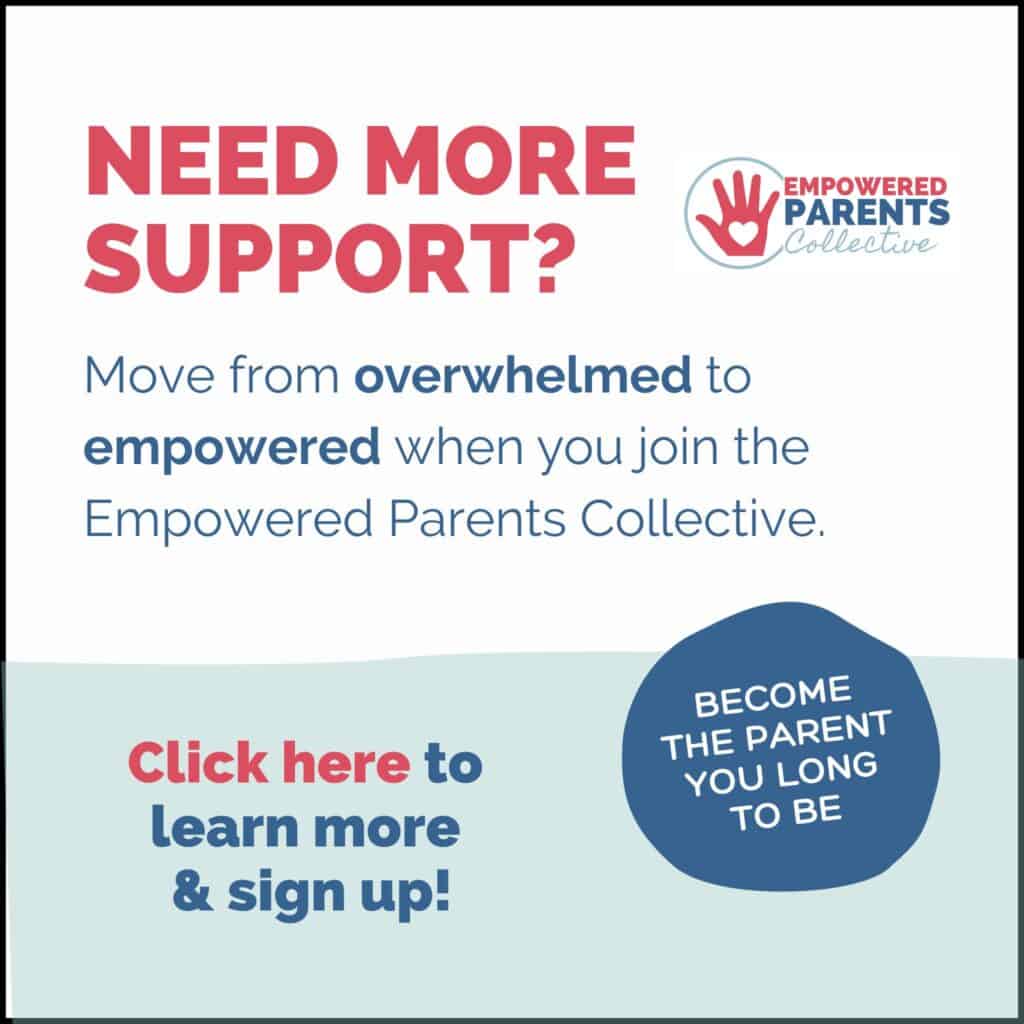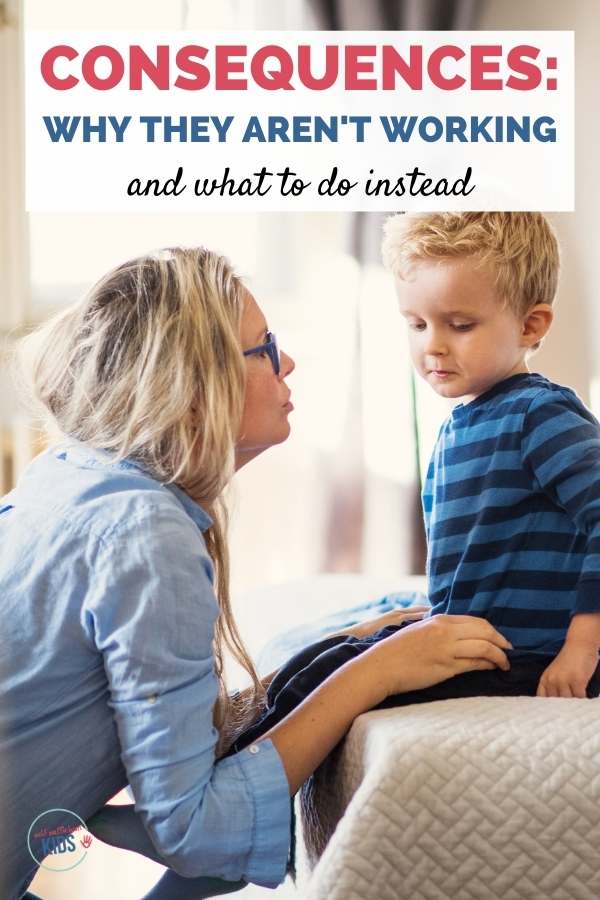Why Logical Consequences Aren’t Working to Change Your Child’s Misbehavior (and What Will)
Many parents try to use consequences to change their child’s misbehavior but find they’re ineffective. Here’s why that happens, how to determine when a consequence will be effective, and seven alternative parenting tools that often work better.

** As an Amazon Associate I earn from qualifying purchases. **
Your daughter has been playing with Magnatiles for the past hour. You love that she’s so engaged in this activity but it’s time to run errands.
“Time to go to the grocery store,” you say.
“No!” she replies.
“I know you’re having fun, honey, but we need to buy food for dinner.”
“No, I’m not going,” she says.
Back and forth the discourse goes for at least another five minutes. Finally, her obstinance has taken you over the edge and you decide it’s time to come up with a consequence for her behavior.
“If you don’t put your coat on in five minutes, I’ll put away the Magnatiles for the next three days.”
Tears start to flow and her cheeks get red. It’s clear she doesn’t like the predicament she’s in.
Magnatiles are her favorite activity, and the thought of being without them for three days is too much to bear. She gets up off the floor and loudly stomps her feet over to the coat rack with a pout on her face.
She’s clearly mad at you and barely says a word the entire time you’re in the car.
It’s painful to see her so upset and angry but you assure yourself that at least she’s learned a lesson.
But has she?
When and why consequences don’t work
Providing a child with a consequence has come to be the modern-day alternative to punishment.
Rather than send a child to their room, or worse, hit them, parents feel they’re teaching their child a lesson by setting up a scenario where the child will feel the repercussions of his or her behavior.
But what most parents don’t realize is that many of the consequences they present to children aren’t truly logical consequences. They don’t teach children and, instead, are really just disguised punishment.
And that’s the reason why they don’t ultimately work.
Research shows that while punishment will change a child’s behavior in the moment, it can cause kids to feel poorly about themselves in the long run, which often inspires greater defiance – leading to more power struggles in the future.
Punishment also damages the parent-child relationship, making it even more difficult for a parent to coach their kids toward better behavior. After being punished, not only do kids feel less of a connection with their parents, children also develop the belief that they’re bad people.
“Punishment is about controlling a child, rather than teaching the child how to control himself. And most often, punishment changes the way a child thinks about himself.”
Amy Morin, Verywell Family
Related: The difference between punishment and discipline
Positive alternatives to consequences
So what’s a parent to do when a child misbehaves?
If using consequences has been in your parenting toolbox for a long time, it may be difficult to think of an alternative. Or you might assume that the only alternative is to be passive and simply let kids get away with bad behavior.
Since passive parenting can also lead to undesirable outcomes, such as children who disregard rules or grow anxious not knowing where their boundaries are, that’s certainly not a good route to take.
Fortunately, parents have other positive discipline techniques to use. These tools empower kids to want to do better while also teaching them how to do better.
7 parenting tools that teach
The following are seven parenting tools that teach rather than punish kids and are usually a better alternative to imposing a consequence.
The more you use these tools in a positive, respectful way the more your children will want to behave better and be more willing to cooperate:
Creating routines: Having a routine doesn’t necessarily solve a parenting dilemma in the moment, but it can help families avoid them in the first place. Children, like adults, don’t like being taken by surprise and having consistency day to day or evening to evening means less resistance when it’s time to brush teeth, take a nap, or run errands, for example. Read more about the benefits of kids routines here.
Problem-solving: In many situations, a child appears defiant or disobedient, but the root problem of these surface behaviors is that they really don’t know how to behave better. For example, you ask your child to clean his room and he appears to ignore you – because he truly doesn’t know the steps to follow to get his room in order. Or a child who is chronically slow getting ready in the morning because she’s playing with her toys instead may simply need guidance to create an efficient morning routine. In these cases, a parent can ask the child for his or her thoughts about how to solve the problem at hand, inviting the child to be a participant in the solution and increasing their desire and ability to do better. Read more about teaching kids how to problem solve here.
A family meeting: Family meetings are an excellent way to work through issues you’re facing as a family, whether it’s between siblings or everyone. If well structured, a consistent family meeting provides a safe forum to let voices be respectfully heard and problem-solving to take place. Read more about best practices with family meetings here.
Offering limited choices: Sometimes the issue at hand is that a child is overwhelmed by the choices he or she is facing. Perhaps too many toys in the playroom overwhelm your daughter with the thought of cleaning it up. Or your son is resisting getting dressed in the morning because he can’t decide what to wear. In these cases, you can eliminate the overwhelm by reducing the number of toys or selecting two outfits for your son to choose from. Giving kids a choice can also be a motivator when there’s resistance to changing activities. You could say: “Which two activities do you want to bring in the car with you when we go pick up your brother at school?” or “Do you want to go to the park or the post office first – you decide.”
Asking for help: Everyone wants to feel capable – especially kids. Sometimes respectfully asking our child for help with an activity will make them more willing to do it. For the child that doesn’t want to get in the car to go grocery shopping you could try: “Will you help me find the groceries we need at the store?” or “Can you help me buckle your car seat straps when we get in the car?”
Deciding what you will do instead of what your child will do: When we tell kids what to do it invites a power struggle. But when we tell our children what we will do it causes them to consider how that will affect them, which gives them agency over their decisions. For example, if your children are young and you are still doing their laundry you could say: “I’m only going to clean the clothing that’s in your hamper.” Or when your child is yelling at you you could calmly state: “I want to hear what you have to say but I don’t talk to people who yell at me.” Just be sure that the message isn’t delivered to try to shame the child. It should simply be a calm explanation of your own standards.
Privileges are lost if responsibility isn’t present: Toys, a bike, a cell phone – these are all items that should be treated with respect by children. Once kids are taught the appropriate way to use them, parents can let kids know that these items will be taken away if they aren’t used properly. However, it’s important not to confuse this lesson in responsibility with taking away privileges as a punishment. For example, taking away a cell phone because curfew wasn’t obeyed isn’t a logical outcome of the behavior.
When logical consequences do work
While many of the consequences parents come up with for their kids don’t work (because they’re really disguised punishment), there are select times when a logical consequence is an effective way to teach a child a lesson and lead him toward better behavior.
But in order for goal of logical consequences to truly be positive, effective, and non-punitive, it must have the following characteristics:
- It’s related to the situation. For example, after a child draws on a wall with a crayon, a related consequence would be that he has to clean the crayon marks off the wall.
- It’s respectful. A consequence isn’t respectful if it’s demeaning, humiliating, or causes pain. It also isn’t respectful if it comes across as dictatorial.
- It’s reasonable. Having a child clean the crayon off the wall and also wash the floor and windows is not a reasonable consequence.
- It’s revealed in advance. Sometimes if a consequence isn’t revealed in advance, it can easily be misconstrued as a punishment. Whenever possible, a parent should set expectations in advance so the child is aware of the consequence of his actions.
These four guidelines (often referred to as the four Rs) can be found in Jane Nelsen’s book, Positive Discipline.
While effective consequences should contain the fourth guideline, “revealed in advance,” it’s not always possible.
Say for example, your child spills orange juice on the kitchen floor. No one could have predicted that would happen so it would be impossible to reveal the consequence of cleaning up the floor in advance.
The important thing to remember here is that your child shouldn’t feel taken off-guard with the consequence presented. If he or she does, the consequence will feel dictatorial and more like a punishment with all the negative outcomes that come with it.
The role of natural consequences in parenting
Outside of logical consequences, which are imposed on kids from someone else, our children also sometimes face natural consequences or situations that follow naturally from a choice our child makes.
An example of a natural consequence is when a child leaves his raincoat at home and then gets wet as he runs from his school bus into the school building. Another example is a teen who procrastinates studying for a test and does poorly on the exam.
If the child or teen facing the natural consequence isn’t “saved” by an adult’s interference, they’ll likely learn a deep lesson that will stay with them as they grow and mature.
However, most children younger than five don’t have the maturity to understand that the consequence they’re experiencing is the result of their behavior.
In addition, a child should not experience a natural consequence when it would jeopardize their health or safety. No parent would let a toddler run into a busy street to learn a lesson about the danger of cars or have them forgo brushing their teeth to let them experience the natural consequence of cavities.
See related: How Natural Consequences Strengthen Kids’ Self-Sufficiency and Confidence
The ultimate goal: to lead our kids toward independence
When we consider the parenting tools we use to help our children and guide them toward better behavior, it’s helpful to remember what our ultimate goal is – helping our kids develop independence and self-reliance.
In the heat of the moment, when we find ourselves in a power struggle with our five-year-old or simply need our child to obey (because we’re at our wit’s end!), that long-term goal can easily end up in the rearview mirror.
The goal then is to gradually progress, little by little, using more constructive parenting tools whenever we can.
And over time we’ll likely find that not only do tantrums, power struggles, and misbehavior decrease, but that our relationship with our child improves and grows stronger.
It’s not always easy to make a change, but with a little diligence, it’s possible—and worth it.
Are you wondering when your child can begin doing certain tasks and chores on their own? Click here to sign up for my weekly emails and you’ll receive my Age-Appropriate Guide to Kids’ Independence as a free gift.
See related:
Why Your Misbehaving Child Won’t Stop and What to Do About it
How to Discipline Kids While Reaching Their Hearts at the Same Time
The Difference Between Punishment and Discipline and Why it Matters
5 Essential Family Rules Every Kid Needs
What to do next…
1. Subscribe to Self-Sufficient Kids’ email list.
Like what you read here and want to learn more? Every Thursday I’ll send you one parenting tip about raising self-sufficient kids and creating the peaceful relationship you yearn to have with your child. Click here to sign up.
2. Take one of my quizzes!
Find out if you’re raising a self-sufficient kid (click here) or if you’re doing too much for your kids (click here). At the end of each quiz, you’ll be asked to provide your email address to see the results.
3. Get your kids started on chores.
Learn how to get your child started on chores (& keep them motivated + avoid power struggles) by enrolling in my Get Your Kids Successfully Started on Chores course. Click here to learn more and sign up.

About Kerry Flatley
Hi! I’m Kerry, the mother of two girls and a certified parent educator. I believe it is possible for parents to have a supportive, loving, and warm relationship with their kids while raising them to be independent and ultimately self-sufficient. Over the years, I’ve read numerous books and articles that support this belief and I’ve put these ideas into practice with my own kids. Read more about me and Self-Sufficient Kids here.



